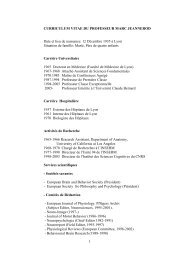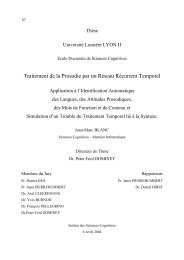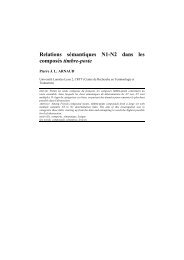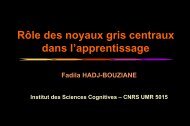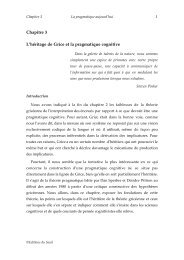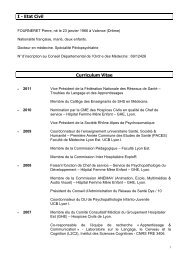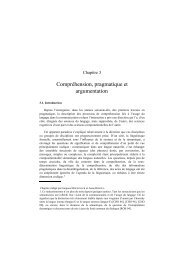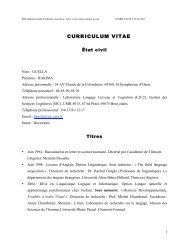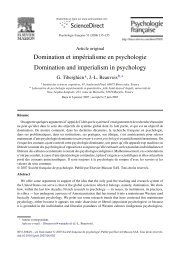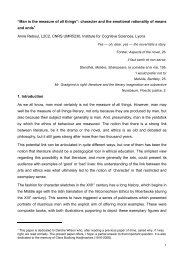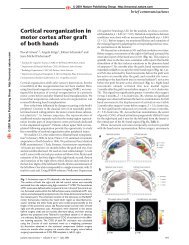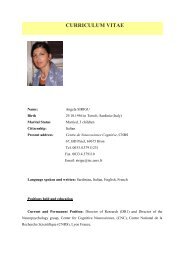- Page 1 and 2:
Darwin en tête ! Épreuve de contr
- Page 3 and 4:
Sous la direction de Jean-Baptiste
- Page 5 and 6:
Liste des auteurs par chapitre Ch a
- Page 7 and 8:
AVANT-PROPOS En 1859, Charles Darwi
- Page 9 and 10:
Avant-propos 9 darwinienne et la g
- Page 11 and 12:
Chapitre 1 La psychologie évolutio
- Page 13 and 14:
La psychologie évolutionniste 13 p
- Page 15 and 16:
La psychologie évolutionniste 15 J
- Page 17 and 18:
La psychologie évolutionniste 17 A
- Page 19 and 20:
La psychologie évolutionniste 19 p
- Page 21 and 22:
La psychologie évolutionniste 21 i
- Page 23 and 24:
La psychologie évolutionniste 23 I
- Page 25 and 26:
La psychologie évolutionniste 25 h
- Page 27 and 28:
La psychologie évolutionniste 27 A
- Page 29 and 30:
La psychologie évolutionniste 29 P
- Page 31 and 32:
La psychologie évolutionniste 31 l
- Page 33 and 34:
La psychologie évolutionniste 33 n
- Page 35 and 36:
Chapitre 2 La psychiatrie darwinien
- Page 37 and 38:
La psychiatrie darwinienne 37 Ici e
- Page 39 and 40:
La psychiatrie darwinienne 39 autre
- Page 41 and 42:
La psychiatrie darwinienne 41 Un au
- Page 43 and 44:
La psychiatrie darwinienne 43 Trois
- Page 45 and 46:
La psychiatrie darwinienne 45 n’
- Page 47 and 48:
La psychiatrie darwinienne 47 L’a
- Page 49 and 50:
La psychiatrie darwinienne 49 par u
- Page 51 and 52:
La psychiatrie darwinienne 51 diset
- Page 53 and 54:
La psychiatrie darwinienne 53 les s
- Page 55 and 56:
La psychiatrie darwinienne 55 pas s
- Page 57 and 58:
La psychiatrie darwinienne 57 de no
- Page 59 and 60:
La psychiatrie darwinienne 59 La th
- Page 61 and 62:
La psychiatrie darwinienne 61 grave
- Page 63 and 64:
La psychiatrie darwinienne 63 l’a
- Page 65 and 66:
La psychiatrie darwinienne 65 certa
- Page 67 and 68:
Chapitre 3 Éthologie et évolution
- Page 69 and 70:
Éthologie et évolution 69 l’app
- Page 71 and 72:
Éthologie et évolution 71 de la c
- Page 73 and 74:
Éthologie et évolution 73 chaque
- Page 75 and 76:
Éthologie et évolution 75 la pair
- Page 77 and 78:
Éthologie et évolution 77 1995).
- Page 79 and 80:
Éthologie et évolution 79 princip
- Page 81 and 82:
Éthologie et évolution 81 exemple
- Page 83 and 84:
Éthologie et évolution 83 alors q
- Page 85 and 86:
Éthologie et évolution 85 d’ind
- Page 87 and 88:
Éthologie et évolution 87 il en d
- Page 89 and 90:
Éthologie et évolution 89 al., 20
- Page 91 and 92:
Éthologie et évolution 91 groupe
- Page 93 and 94:
Éthologie et évolution 93 explore
- Page 95 and 96:
Éthologie et évolution 95 dans d
- Page 97 and 98:
Éthologie et évolution 97 ventral
- Page 99 and 100:
Éthologie et évolution 99 ont en
- Page 101 and 102:
Chapitre 4 Psychologie évolutionni
- Page 103 and 104:
Psychologie évolutionniste et scie
- Page 105 and 106:
Psychologie évolutionniste et scie
- Page 107 and 108:
Psychologie évolutionniste et scie
- Page 109 and 110:
Psychologie évolutionniste et scie
- Page 111 and 112:
Psychologie évolutionniste et scie
- Page 113 and 114:
Psychologie évolutionniste et scie
- Page 115 and 116:
Psychologie évolutionniste et scie
- Page 117 and 118:
Psychologie évolutionniste et scie
- Page 119 and 120:
Psychologie évolutionniste et scie
- Page 121 and 122:
Psychologie évolutionniste et scie
- Page 123 and 124:
Psychologie évolutionniste et scie
- Page 125 and 126:
Chapitre 5 De la psychologie évolu
- Page 127 and 128:
De la psychologie évolutionniste
- Page 129 and 130:
De la psychologie évolutionniste
- Page 131 and 132:
De la psychologie évolutionniste
- Page 133 and 134:
De la psychologie évolutionniste
- Page 135 and 136:
De la psychologie évolutionniste
- Page 137 and 138:
De la psychologie évolutionniste
- Page 139 and 140:
De la psychologie évolutionniste
- Page 141 and 142:
De la psychologie évolutionniste
- Page 143 and 144:
De la psychologie évolutionniste
- Page 145 and 146:
De la psychologie évolutionniste
- Page 147 and 148:
De la psychologie évolutionniste
- Page 149 and 150:
De la psychologie évolutionniste
- Page 151 and 152:
De la psychologie évolutionniste
- Page 153 and 154:
De la psychologie évolutionniste
- Page 155 and 156:
De la psychologie évolutionniste
- Page 157 and 158:
De la psychologie évolutionniste
- Page 159 and 160:
chapitre 6 Archéologie cognitive :
- Page 161 and 162:
Archéologie cognitive : de la mati
- Page 163 and 164:
Archéologie cognitive : de la mati
- Page 165 and 166:
Archéologie cognitive : de la mati
- Page 167 and 168:
Archéologie cognitive : de la mati
- Page 169 and 170:
Archéologie cognitive : de la mati
- Page 171 and 172:
Archéologie cognitive : de la mati
- Page 173 and 174:
Archéologie cognitive : de la mati
- Page 175 and 176:
Archéologie cognitive : de la mati
- Page 177 and 178:
Archéologie cognitive : de la mati
- Page 179 and 180:
Archéologie cognitive : de la mati
- Page 181 and 182:
Archéologie cognitive : de la mati
- Page 183 and 184:
Archéologie cognitive : de la mati
- Page 185 and 186:
Archéologie cognitive : de la mati
- Page 187 and 188:
Archéologie cognitive : de la mati
- Page 189 and 190:
Archéologie cognitive : de la mati
- Page 191 and 192:
Archéologie cognitive : de la mati
- Page 193 and 194:
Chapitre 7 Linguistique et Évoluti
- Page 195 and 196:
Linguistique et Évolution 195 Ces
- Page 197 and 198:
Linguistique et Évolution 197 en q
- Page 199 and 200:
Linguistique et Évolution 199 Selo
- Page 201 and 202:
Linguistique et Évolution 201 terr
- Page 203 and 204:
Linguistique et Évolution 203 - Ma
- Page 205 and 206:
Linguistique et Évolution 205 à g
- Page 207 and 208:
Linguistique et Évolution 207 pré
- Page 209 and 210:
Linguistique et Évolution 209 L’
- Page 211 and 212:
Linguistique et Évolution 211 dét
- Page 213 and 214:
Linguistique et Évolution 213 On r
- Page 215 and 216:
Linguistique et Évolution 215 les
- Page 217 and 218:
Linguistique et Évolution 217 Plus
- Page 219 and 220:
Linguistique et Évolution 219 puis
- Page 221 and 222:
Chapitre 8 Neurosciences cognitives
- Page 223 and 224:
Neurosciences cognitives et évolut
- Page 225 and 226:
Neurosciences cognitives et évolut
- Page 227 and 228:
Neurosciences cognitives et évolut
- Page 229 and 230:
Neurosciences cognitives et évolut
- Page 231 and 232:
Neurosciences cognitives et évolut
- Page 233 and 234:
Neurosciences cognitives et évolut
- Page 235 and 236:
Neurosciences cognitives et évolut
- Page 237 and 238:
Neurosciences cognitives et évolut
- Page 239 and 240:
Neurosciences cognitives et évolut
- Page 241 and 242:
Neurosciences cognitives et évolut
- Page 243 and 244:
Neurosciences cognitives et évolut
- Page 245 and 246:
Neurosciences cognitives et évolut
- Page 247 and 248:
Neurosciences cognitives et évolut
- Page 249 and 250:
Neurosciences cognitives et évolut
- Page 251 and 252:
Neurosciences cognitives et évolut
- Page 253 and 254:
Chapitre 9 Intelligence artificiell
- Page 255 and 256:
Intelligence artificielle et évolu
- Page 257 and 258:
Intelligence artificielle et évolu
- Page 259 and 260:
Intelligence artificielle et évolu
- Page 261 and 262:
Intelligence artificielle et évolu
- Page 263 and 264:
Intelligence artificielle et évolu
- Page 265 and 266: Intelligence artificielle et évolu
- Page 267 and 268: Intelligence artificielle et évolu
- Page 269 and 270: Intelligence artificielle et évolu
- Page 271 and 272: Intelligence artificielle et évolu
- Page 273 and 274: Intelligence artificielle et évolu
- Page 275 and 276: Chapitre 10 Philosophie : modularit
- Page 277 and 278: Philosophie : modularité et psycho
- Page 279 and 280: Philosophie : modularité et psycho
- Page 281 and 282: Philosophie : modularité et psycho
- Page 283 and 284: Philosophie : modularité et psycho
- Page 285 and 286: Philosophie : modularité et psycho
- Page 287 and 288: Philosophie : modularité et psycho
- Page 289 and 290: Philosophie : modularité et psycho
- Page 291 and 292: Philosophie : modularité et psycho
- Page 293 and 294: Philosophie : modularité et psycho
- Page 295 and 296: Philosophie : modularité et psycho
- Page 297 and 298: Philosophie : modularité et psycho
- Page 299 and 300: Philosophie : modularité et psycho
- Page 301 and 302: Philosophie : modularité et psycho
- Page 303 and 304: Philosophie : modularité et psycho
- Page 305 and 306: Philosophie : modularité et psycho
- Page 307 and 308: Philosophie : modularité et psycho
- Page 309 and 310: Bibliographie Adolphs, R. (2009). T
- Page 311 and 312: Bibliographie 311 Barkow, J. H., Co
- Page 313 and 314: Bibliographie 313 Benedict, R. (193
- Page 315: Bibliographie 315 Bowlby, J. 1969.
- Page 319 and 320: Bibliographie 319 Castelli, F., Hap
- Page 321 and 322: Bibliographie 321 Corsi, P., Gayon,
- Page 323 and 324: Bibliographie 323 Dasser, V. 1988.
- Page 325 and 326: Bibliographie 325 Diamond, J. (2005
- Page 327 and 328: Bibliographie 327 Emery, N. J. 2004
- Page 329 and 330: Bibliographie 329 Fessler, D. and C
- Page 331 and 332: Bibliographie 331 Galea, L. A., Kav
- Page 333 and 334: Bibliographie 333 Goldin-Meadow, S.
- Page 335 and 336: Bibliographie 335 Hare, B., Call, J
- Page 337 and 338: Bibliographie 337 Holekamp, K. E.,
- Page 339 and 340: Bibliographie 339 Johnson, S.P., Sl
- Page 341 and 342: Bibliographie 341 Kitcher, P. (1985
- Page 343 and 344: Bibliographie 343 Lewis-Williams, D
- Page 345 and 346: Bibliographie 345 McBrearty, S. & B
- Page 347 and 348: Bibliographie 347 Morwood, M. J., S
- Page 349 and 350: Bibliographie 349 Origgi, G., & Spe
- Page 351 and 352: Bibliographie 351 Poirier, P., L. F
- Page 353 and 354: Bibliographie 353 Quartz, S. R., &
- Page 355 and 356: Bibliographie 355 Ruff, C. B., Trin
- Page 357 and 358: Bibliographie 357 Sherwood, C. C.,
- Page 359 and 360: Bibliographie 359 Sperber, D., & Cl
- Page 361 and 362: Bibliographie 361 Takagi, N. (2002)
- Page 363 and 364: Bibliographie 363 Underhill, P. A.
- Page 365 and 366: Bibliographie 365 Wilson, D. S., &
- Page 367 and 368:
Index des notions A Adaptation 101,
- Page 369 and 370:
Index des notions 369 Génétique (
- Page 371 and 372:
Table des matières Li s t e d e s
- Page 373 and 374:
Table des matières 373 Chapitre 4
- Page 375 and 376:
Table des matières 375 Chapitre 8



